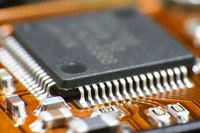Modern Electronic Devices To Be Even More Compact
The new breakthrough of an international scientific group might be a microscopic step for the electronics industry, but a huge step for mankind. The scientists’ invention will allow making contemporary electronic devices even more compact. The scientists were able to reduce the thickness of copper conductors on printed circuits and the distance between them. Earlier unknown chemical reaction between copper and silicon made this breakthrough possible.

For over 40 years, the electronics industry has been sticking with the goal of making new devices more compact and efficient. However, for many years scientists have been leading discussions about reaching the technological limits of miniaturization that the industry would not be able to overcome.
At the same time, scientists are conducting research aimed at overcoming these limits and prevention of stagnation of the microelectronics industry. World’s leading institutes come together to solve this problem.
A group of American and French scientists was able to achieve these results using little known chemical reactions that occur on the border of an electric conductor and the bedding of a printed circuit made of special materials.
The researchers placed a conductor made of copper and manganese on a bed of silicon dioxide and exposed this “sandwich” to the temperature of 420°C for an hour. It resulted in the formation of a new double dielectric layer of manganese dioxide and rhodonite mineral (manganese polysilicate).
Both substances are low - k dielectrics, which means that their dielectric permittivity factor is less than 2. Such materials are necessary for the development of multi-layered integral electronics. However, their creation is currently hindered by an expensive production process.
The new breakthrough completely changes the situation. A cheap way of producing low - k dielectrics creates opportunities for new devices with the increased speed of electrotransmission. Besides, the features of new materials allow placing the components of electrical schemes much closer to each other without a threat of mutual background influence.
Pravda.ru interviewed Russian scientists to find out their opinion on the future of low-k electronics in light of the latest breakthrough.
Vladimir Kazakov, Moscow State Institute of Radiotechnics, Electronics and Automatics:
“Sooner or later, the progress achieved in the area of micro- and nanoelectronics will result in convergence of these two areas. It will be much easier to construct devices that combine new opportunities for both areas.”
Stepan Miroshkin, the Moscow Institute of Physics and Technology: “These results are not yet the limits for this development. At least until it is proven otherwise. So I think that the most interesting breakthroughs for the microelectronics industry are still ahead.”
Anatoly Romanyuk, Moscow State Technical University n.a. N.E. Bauman (MSTU): “For years or even decades to come, microelectronics will be closer to the end user than nanotechnologies. The fact that this breakthrough allows modernization of the existing industry without capital investments will be beneficial for the entire industry. It will be much easier for manufacturers to implement new models, and the customer will get access to compact and efficient devices.”
Pavel Urushev
Pravda.Ru
Subscribe to Pravda.Ru Telegram channel, Facebook, RSS!


